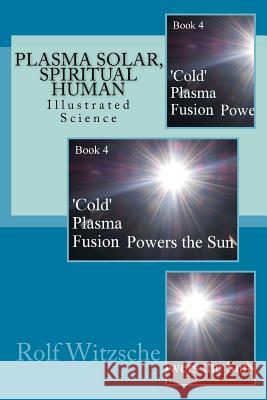Plasma Solar, Spiritual Human: Illustrated Science » książka
Plasma Solar, Spiritual Human: Illustrated Science
ISBN-13: 9781523804276 / Angielski / Miękka / 2016 / 124 str.
Plasma in the physical universe is as challenging in perception as the spiritual domain in human sphere. Both are invisible, except by their effects. And often, the effects too, are hard to recognize. In cosmic space, plasma streams have resonance cycles according to their physical size. On the galactic scale the resonances are measured in millions of years per cycle, such as the 31 and 145 million-year cycles. Both are presently at their low point, and overlapping. That's why we have to deal with Ice Age cycles that become critical during low-density plasma conditions in the galaxy. And this is where we are at today. With the Ice Age Challenge now before us, we face two imperatives. One is to understand the physical dynamics, and to create the physical infrastructures that enable human living to continue in an Ice Age climate. The second challenge is to raise up our humanity to such height as will impel us to get the job done. Some say that miracles are needed on both fronts. But what of it? Are we, as human beings, not the miracle makers on the Earth? In the real universe, the cosmic operations are anti-entropic in nature, and expanding and progressing. We, ourselves are evidence of this progression. Should this progression have ended? Neither is our Sun isolated from the progressive nature of the universe, but expresses its dynamics, its resonating plasma streams, and their reflection in the climate on Earth. Shouldn't we develop ourselves spiritually and culturally, likewise? Climate Change reflects the nature of the universe. It should also be reflected in us. The Earth itself is the creation of the Sun, with its atoms having been massively synthesized in high-energy times near the center of the galaxy. The synthesizing plasma fusion is presently at a low state, though it is currently enhanced for our Sun by electromagnetic 'Primer Fields' that focus interstellar plasma onto the Sun in a highly condensed manner. When the plasma-focusing system becomes inactive, below the required threshold conditions, the Sun reverts to a type of cosmic default level with 70% less energy being radiated, and higher rates of solar cosmic-ray flux being experienced. At the present rate of plasma diminishment being experienced, the solar activity phase-shift threshold to the next Ice Age period may be crossed in 30 years, or in the 2050s, most likely. With the primer-fields system gone inactive by then, the climate on Earth will get 40 times colder than the Little Ice Age in the 1600s had been. Ice core evidence promises that. Without the needed preparations for human living in such an environment, 99% of humanity would die of starvation, both by the cold, and by CO2 depletion that diminishes agriculture, as more CO2 becomes dissolved into the sea. With the 'Primer Fields' being critical for our very existence, the exploration of them is likewise critical. In the Little Ice Age, between 10% and up to 30% of the populations in Europe had perished by starvation. The last Big Ice Age was evidently vastly harsher. Only 1-10 million people emerged from it alive. That's all we had after 2 million years of development. We want to do far better this time around; and we can, with large-scale technological infrastructures for our food supply. But will we create them? Will we get the job done in the 30 years that we still have left before the Ice Age starts anew? Will we even consider it? And how certain are we that the phase shift to the next glaciation period will begin, as the evidence suggests, in the 2050s? We have no slack on this front. Should we fail us on this absolute front, we would be committing suicide.
Zawartość książki może nie spełniać oczekiwań – reklamacje nie obejmują treści, która mogła nie być redakcyjnie ani merytorycznie opracowana.











